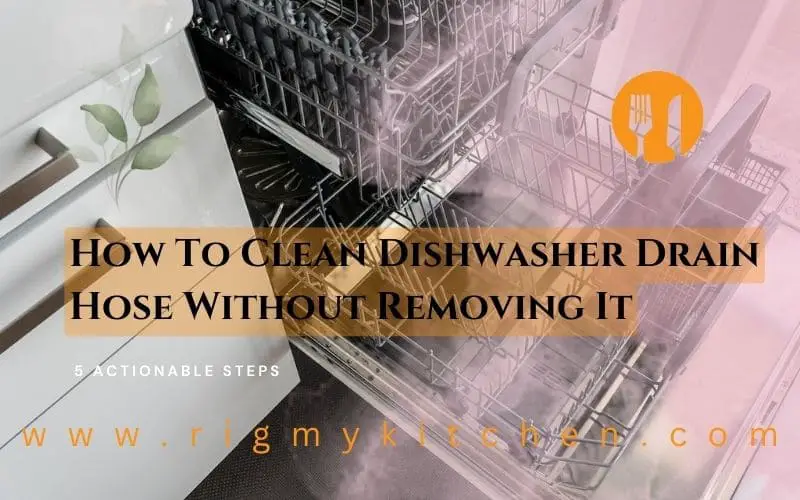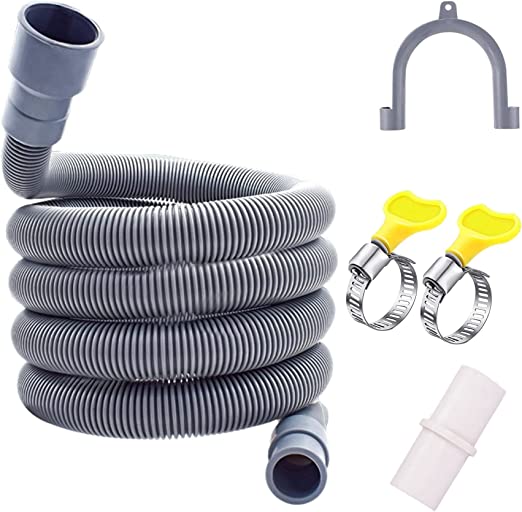A dishwasher is an essential kitchen tool, and the dishwasher drain hose is a necessary component of your dishwasher. Since the drain hose connects the dishwasher to the garbage disposal, food particles can easily get stuck. So, like every other piece of kitchen equipment, if it is not cleaned, it will malfunction and might even create more cleaning for you at the end of the day. However, is there a hack to the process? Wondering How To Clean Dishwasher Drain Hose Without Removing It?
Sometimes, getting an appliance like a dishwasher professionally cleaned can get expensive. Before taking that decision, it is financially smart and sustainable to try to fix the one you have on your own. The drain hose is prone to clogging from food particles and grease buildup.
Let’s take a look at what a drain hose is, what contributes to clogs, and how to go about the clog removal process.
What Is A Dishwasher Drain Hose?
A dishwasher drain hose is the tube that connects the dishwasher to the garbage disposal. The hose is commonly located either under the sink or behind the dishwasher. Wherever the location, it functions the same and requires cleaning.
Does A Dishwasher Hose Require Cleaning?
Yes! Food particles and other debris can easily clog the tube, causing it to malfunction, and as a result, the dishwasher might not function at its fullest capacity. This happens faster if the dishes are not rinsed before being placed in the dishwasher. Regardless, over time debris builds up and clogs the tube, for which it is necessary to clean the hose. Drain hose cleaning is, in most cases, not something you would need to call in a plumber for but something you can accomplish at home with the supplies you already have.
How Do You Identify A Clogged Dishwasher Hose?
There are some telltale signs for a clogged hose which can easily tell you that it is time for a cleaning:
Unusual gurgling noises while using the dishwasher
If you hear gurgling or thumping noises when using your dishwasher, that is the first red flag that your plumbing maintenance is not quite right. The noises are an indication of a clog in the hose and it happens when water is trying to pass the blockage. All this means is that your hose needs a cleaning, not that there’s anything wrong with the dishwasher itself.
The water drainage of the dishwasher is much slower than normal
If both the kitchen sink and dishwasher start to drain water at a slower rate than usual, then a clog is confirmed. As the clog is likely to build up over time, it could cause flooding and make a bigger mess which can be avoided.
Dishes come out unclean
This is perhaps the most straightforward and obvious sign that the dishwasher is not functioning properly. A clog can obstruct how the water passes resulting in your dishes not being cleaned properly. In other cases, it could also be because of the type of detergent you are using or incorrectly loading the dishes.
Leftover water
If you see that there is water leftover in the dishwasher afterwards or that there is a puddle of water at the bottom of the dishwasher, you could have a clogged drain. It means that the water is not draining properly. Not only does the leftover water leave you with more cleaning but also damages other equipment and hampers your kitchen hygiene by attracting insects and housing molds.
Steps to Clean the Dishwasher Drain Hose
Now that we know how to identify a clogged drain hose, it is time to start cleaning! Cleaning the dishwasher drain hose might sound like an unnerving task. However, that is not the case. The good news is that the hose can be easily cleaned without removing it and by using household supplies that you already have in your cupboard and fridge.
Here’s a step-by-step on how to go about the process:
Step 1: Empty Your Dishwasher
It might sound obvious, but when panicking over a machine that you cannot imagine your day-to-day without, it is easy to forget. Be sure to unload all the dishes, and if they are still dirty, do not forget to keep them separate from the clean ones.
Step 2: Turn Off The Power
Once you have done so, turn off the circuit breaker and the waste disposal. This is crucial to avoid any electrical mishaps or accidents and to keep yourself safe during the process.
Step 3: Remove The Bottom Rack
To access the dishwasher drain hose easier, you can remove the bottom rack. Depending on your dishwasher model, you may need to check the filter as well which could be either located at the back or bottom of the dishwasher.
Step 4: Inspect The Garbage Disposal
When tackling a clog, start by checking your garbage disposal before getting down and dirty. Let your disposal eat up any large chunks of debris or leftover food particles to get the cleaning process started.
If, after this step, you no longer see any clogs or debris, it is likely that your dishwasher will be back to normal. However, if you are facing a stubborn clog, move on to the next step!
Step 5: Vinegar And Baking Soda
This is an easy DIY cleaning process that you can do on your own and with ease. Start by adding equal parts of vinegar and baking soda to the dishwasher basket, which is usually found at the bottom of the dishwasher. Let the mixture sit for a while. After 15-20 minutes, pour hot water into the basket and begin the rinse cycle to clear the clog.
This cleaning solution is quite effective for appliance maintenance, especially for the dishwasher drain hose, because the vinegar helps to remove the grease and grime. It makes the clog removal process easier and more effective. Additionally, vinegar and baking soda are natural deodorizers, so they prevent any unpleasant odors and clean your dishwasher hose with ease.
These steps should help restore the performance of your dishwasher. However, if it does not, you might want to check the dishwasher’s air gap for cleaning and the filter. If your dishwasher has an air gap, you should clean it as well because it could be the source of your clog and overflowing water.
Just to recap, here are some precautions to keep in mind during the cleaning process:
- You can choose to wear rubber gloves while handling the different parts and cleaning solution
- Make sure the power is cut from the dishwasher to avoid any electrocutions or accidents
- Unload all the dishes before removing any racks
Read more to know How To Deodorize Dishwasher With Baking Soda.
How Often Should You Clean Your Dishwasher?
It is wise to keep your dishwasher clean internally even before the signs of a clog start showing. Try to clean the drain hose once a month, and in doing so, it will remove any buildup that can cause a clog, making your life a little easier.
Household cleaning can be a taxing chore. Sometimes we forget to include appliance maintenance and a thorough cleaning of all household equipment that we use daily. However, it is wise to make space for these chores at least once a month when it comes to cleaning appliances like dishwashers before they start showing signs of a malfunction.
FAQs on How To Clean Dishwasher Drain Hose Without Removing
Why is it important to clean the dishwasher drain hose?
Since the dishwasher drain hose connects the dishwasher to the garbage disposal, sometimes food particles and other debris can get stuck on the tube walls. This buildup over time causes a clog to form, which hampers the overall cleaning process and leaves you behind with dirty plates and a wet floor. In the worst cases, over-following on the kitchen countertop. Hence, cleaning the dishwasher drain hose is crucial.
What are some tools or materials you will need to clean the drain hose?
The materials and tools you will need are likely those you already have – a pair of rubber gloves, baking soda, vinegar, and hot water. Click here to buy gloves from Amazon
Can you use vinegar or baking soda to clean the dishwasher drain hose?
Yes! Vinegar and baking soda make a cleaning solution that can be used to clean not only the dishwasher drain hose but also other appliances as well.
How do you use a wire hanger to clean the dishwasher drain hose?
This will require you to disconnect the hose. After doing so, wiggle the hose to loosen any debris. Then, use a straightened wire hanger to insert it into the hose and remove any debris that may be trapped inside.
Are there any dishwasher cleaning products that can help clean the drain hose?
There are many cleaning products available on the market that are made specifically for this purpose.
Is it necessary to use a dishwasher-safe cleaner when cleaning the drain hose?
Yes! Commercial dishwasher-safe cleaners can be used as well. These solutions wash away any food particles and prevent grease from staying back in the hose.
Final Thoughts
DIY cleaning processes for making cleaning solutions make our lives easier as they do not require us to invest in extra supplies or work with hazardous chemicals. Overall, with a little pre-planning, maintaining kitchen hygiene and household cleaning can be accomplished easily with the supplies we have on hand. And, that the end of today’s discussion on how to clean dishwasher drain hose without removing it.
Spread the joy with others


Written By Jeanette Wilson
Jeanette Wilson has spent the last 12+ years designing, testing, and improving kitchen gadgets and appliances. She also knows her way around a home and professional kitchen, as she is a passionate home cook and runs her own roadside eatery.